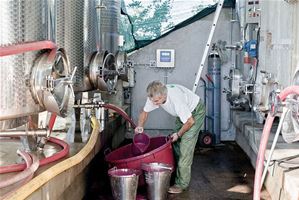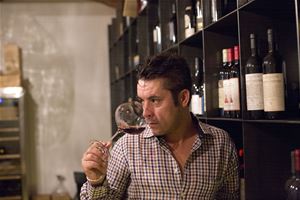The French term vin nouveau and its Italian counterpart, vino novello, literally mean ‘new wine.’ However, the ‘new’ in nouveau and novello of these wines is literal in another sense: while governo all’ uso toscano has been reintroduced of late, vin nouveau and vino novello are relatively recent inventions, made possible by innovations of the past 80 years—making them ripe for modern marketing techniques.
Back in the 1990s, when I started drinking wine, my home state of New Jersey was at the tail end of a Beaujolais nouveau ‘boom,’ propelled in part by the French négociant Georges Duboeuf and in part by my neighborhood’s wine-salesman-cum-celebrity-social-media-guru, Gary Vaynerchuk. I’m sure I am not the only one whose early taste was strongly influenced by this light, low-alcohol, fruity and easy-to-drink wine. The wine’s traditional November release date, just in time to kick off the holiday season, which starts with Thanksgiving in the United States, and its colorful labels and merry marketing campaign Le Beaujolais nouveau est arrivé! (‘The new Beaujolais has arrived!’) helped win over many fans.
But even before that, in the 1970s, following the earlier commercial success of the vin nouveau, Italy had introduced its own version, vino novello (not to be confused with vino nuovo, which simply refers to a newly released vintage), later obtaining official recognition through a ministerial decree in 1989. What both Beaujolais nouveau and vino novello wines have in common, along with an appeal to younger tastes, is technological innovation.
In the 1930s, building upon an earlier observation of French chemist Louis Pasteur, fellow Frenchman M. Michel Flanzy conducted experiments that led to an entirely new vinification process: carbonic maceration. While on the vine, whole grapes ‘breathe’—that is, they respire—exchanging oxygen and carbon dioxide between their cells and the external environment. In an atmosphere deprived of oxygen and rich in carbon dioxide, the grapes begin to consume their own internal oxygen reserves before eventually consuming their own sugars.
This enzymatic process within the living grapes, called intracellular fermentation, produces alcohol without relying on yeast. Whereas traditional vinification techniques can take months to produce a smooth, easy-drinking wine, carbonic maceration can take as little as seven days to yield the same result, generating significant cash flow to cash-strapped farmers within weeks of the wine harvest.
Cash-flow trouble might seem like a strange concept if your idea of a winery involves a Tuscan castello or a French chateau, but unless you’re a huge producer such as Gaja, Antinori or Gruppo Italiano Vini, at the end of a season that involves endless preventive measures against disease and vineyard pests—like the rainy one we’ve had this year—you’re probably ending the harvest very low on funds.
In centuries past, the duration (up to one year) between the September/October harvest and the wine sale was a time of hardship for most farmers. Timing was especially crucial in Tuscany, where new wine tended to be harshly tannic and unpalatable for your average consumer. In the absence of a modern temperature-controlled environment, only at the end of summer when the wine began to soften that farmers were able to generate any revenue. Purchases for necessities such as shoes, clothing and new equipment had to wait.
It wasn’t until another technical innovation, governo all’uso toscano, was introduced that farmers were able to shave critical months off of the time from harvest to sale by adding partially dried grapes to fermenting wine, thereby catalyzing a secondary fermentation that softened the wine in time for spring.
The next time you find yourself in front of a glass of Beaujolais nouveau, vino novello or governo wine, keep in mind those small farmers and each of the technical innovations that helped to improve their lot.
As the nights begin to draw in and hats and scarves are pulled out from the back of wardrobes, the wintry months in Tuscany are alive and kicking with fresh produce.
Festival of new oil
Piazza Santo Spirito, Florence
November 16, 9am–7pm
Terre Fiorenti: New wine festival
Galleria delle Carrozze, Palazzo Medici Riccardi, via Cavour, Florence
December 19–21
Terre Fiorenti: New extra-virgin olive oil
Galleria delle Carrozze, Palazzo Medici Riccardi, via Cavour, Florence
November 21–23
Florence Wine Event 2014
Giardino dell’Orticoltura, via Vittorio Emanuele II 4, Florence
November 29–30
‘Buco Unto’ festival: new oil and wine – Civitella Paganico, near Grosseto 8–9 November
www.facebook.com/ProLocoCivitellaMarittima
New oil fair: Olive oil tastings/live music
Montemurlo, Prato
November 9–17
Il Desco 2014
Real Collegio, Lucca
November 15–December 8
Colours and Scents of Montalbano
Vinci, December 6–7
To reserve and for information, call 340/7640256.






